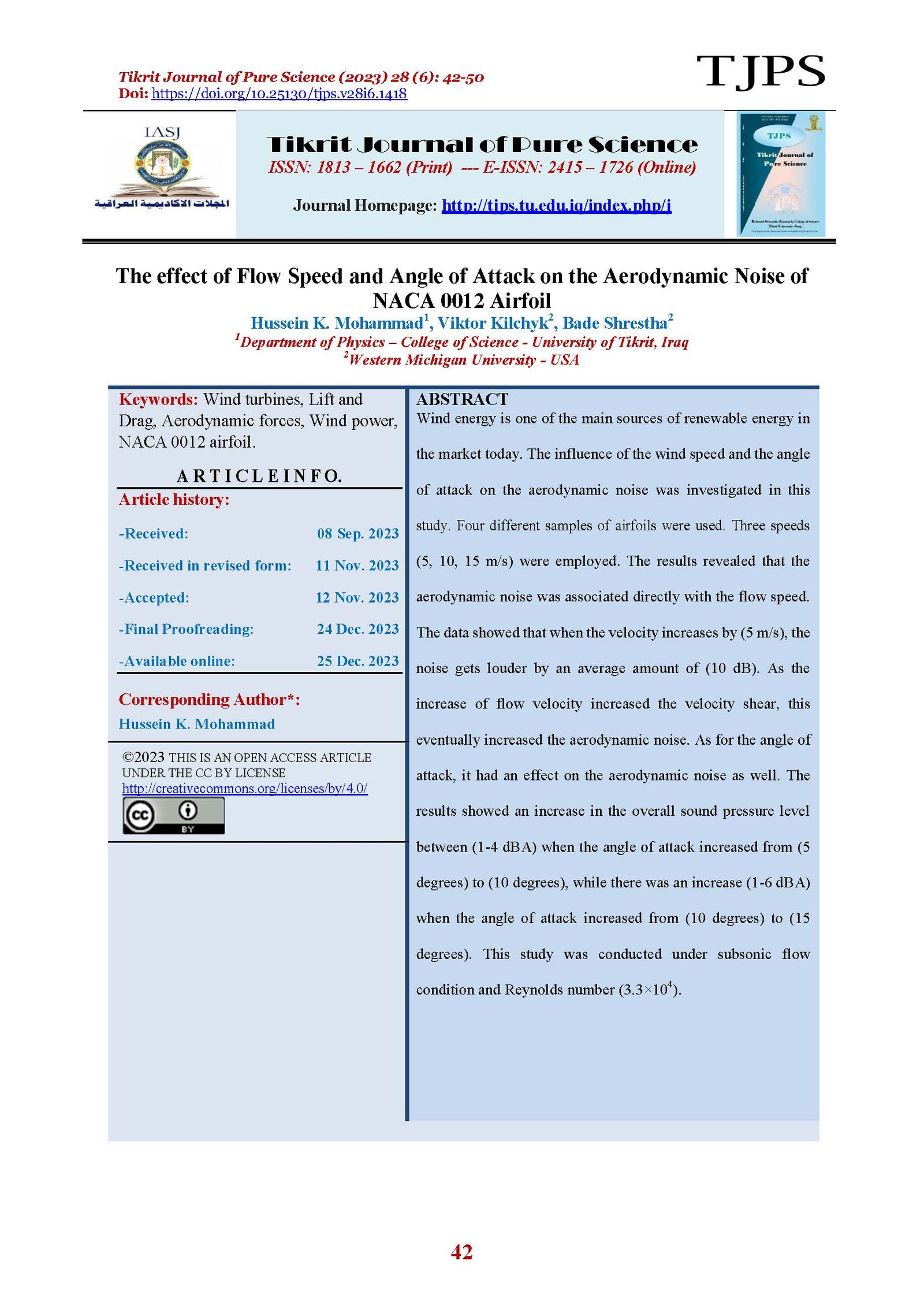The effect of Flow Speed and Angle of Attack on the Aerodynamic Noise of NACA 0012 Airfoil
Main Article Content
Abstract
Wind energy is one of the main sources of renewable energy in the market today. The influence of the wind speed and the angle of attack on the aerodynamic noise was investigated in this study. Four different samples of airfoils were used. Three speeds (5, 10, 15 m/s) were employed. The results revealed that the aerodynamic noise was associated directly with the flow speed. The data showed that when the velocity increases by (5 m/s), the noise gets louder by an average amount of (10 dB). As the increase of flow velocity increased the velocity shear, this eventually increased the aerodynamic noise. As for the angle of attack, it had an effect on the aerodynamic noise as well. The results showed an increase in the overall sound pressure level between (1-4 dBA) when the angle of attack increased from (5 degrees) to (10 degrees), while there was an increase (1-6 dBA) when the angle of attack increased from (10 degrees) to (15 degrees). This study was conducted under subsonic flow condition and Reynolds number (3.3×104).
Article Details

This work is licensed under a Creative Commons Attribution 4.0 International License.
Tikrit Journal of Pure Science is licensed under the Creative Commons Attribution 4.0 International License, which allows users to copy, create extracts, abstracts, and new works from the article, alter and revise the article, and make commercial use of the article (including reuse and/or resale of the article by commercial entities), provided the user gives appropriate credit (with a link to the formal publication through the relevant DOI), provides a link to the license, indicates if changes were made, and the licensor is not represented as endorsing the use made of the work. The authors hold the copyright for their published work on the Tikrit J. Pure Sci. website, while Tikrit J. Pure Sci. is responsible for appreciate citation of their work, which is released under CC-BY-4.0, enabling the unrestricted use, distribution, and reproduction of an article in any medium, provided that the original work is properly cited.
References
[1] Goodarzi, M., R. Fereidouni, and M. Rahimi. (2012).”Investigation of Flow Control over a NACA 0012 Airfoil by Suction Effect on Aerodynamic Characteristics.” Canadian Journal on Mechanical Sciences and Engineering 3 (3): 102109.
[2] Berger RG, Ashtiani P, Ollson CA, et al. Health-based audible noise guidelines account for infrasound and low-frequency noise produced by wind turbines. Front Public Health 2015; 3: 114.
[3] Booma Devi, P., and Dilip A. Shah. (2016).”Computational Analysis of Cavity Effect over Aircraft Wing.” World Academy of Science, Engineering and Technology International Journal of Mechanical, Aerospace, Industrial, Mechatronic and Manufacturing Engineering 10 (4).
[4] Makwana, P. B., and J. J. Makadiya. (2014). Numerical Simulation of Flow over Airfoil and Di_erent Techniques to Reduce Flow Separation along with Basic CFD Model: A Review Study. International Journal of Engineering Research and Technology (IJERT) 3 (4): 399404.
[5] V. Katinas, M. Marčiukaitis and M. Tamašauskienė. (2016). "Analysis of the wind turbine noise emissions and impact on the environment," Renewable and Sustainable Energy Reviews, vol. 58, pp. 825-831.
[6] Leloudas, G., Zhu, W. J., Sørensen, J. N., Shen, W. Z., & Hjort, S. (2007, July). Prediction and reduction of noise from a 2.3 MW wind turbine. In Journal of physics: conference series (Vol. 75, No. 1, p. 012083). IOP Publishing.
[7] Sumesh, C. K., & Jothi, T. J. S. (2021). Aerodynamic noise from an asymmetric airfoil with perforated extension plates at the trailing edge. International Journal of Aeroacoustics, 20(1-2), 88-108.
[8] Murugan, S. S., Natarajan, V., & Kumar, R. R. (2011). Noise model analysis and estimation of effect due to wind driven ambient noise in shallow water. International Journal of Oceanography, 2011.
[9] Piggott, C. L. (1964). Ambient sea noise at low frequencies in shallow water of the Scotian Shelf. The Journal of the Acoustical Society of America, 36(11), 2152-2163.
[10] W. Siegfried, R. Bareiß and G. Guidati, "Noise mechanisms of wind turbines," in Wind Turbine Noise, Berlin, Heidelberg, Springer, 1996, pp. 67-92.
[11] Lighthill, M. J. (1952). On sound generated aerodynamically I. General theory. Proceedings of the Royal Society of London. Series A. Mathematical and Physical Sciences, 211(1107), 564-587.
[12] Laratro, A., Arjomandi, M., Cazzolato, B., & Kelso, R. (2017). Self-noise of NACA 0012 and NACA 0021 aerofoils at the onset of stall. International Journal of Aeroacoustics, 16(3), 181-195.
[13] Mohammad, H. K. (2022). Channeling Influence on Noise and Aerodynamic Performance of NACA 0012 Airfoil as a Possible Solution of Wind Turbines Noise (Doctoral dissertation), Western Michigan University).
[14] Hutcheson, F. V., & Brooks, T. F. (2006). Effects of angle of attack and velocity on trailing edge noise determined using microphone array measurements. International Journal of Aeroacoustics, 5(1), 39-66.
